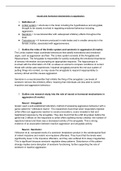Exam (elaborations)
Aggression - Psychology AQA A Level Questions and Answers
- Course
- Institution
This document provides questions and answers to different possible exam questions in the A level AQA Psychology exam for the Aggression section of paper three. The questions range from 2 marks questions to the long 16 marks essay questions, all of which an answer is provided! From these 16 mark ans...
[Show more]



